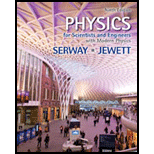
(a)
The longest wavelength in the rotational spectrum of the HCl molecule.
(a)
Answer to Problem 19P
The longest wavelength in the rotational spectrum of the HCl molecule is
Explanation of Solution
The longest wavelength for a rotational spectrum of a molecule will be obtained if the transition occurs between
Write expression for the energy of rotational levels.
Here,
Write the expression for the energy difference between
Here,
Write the expression for the change in energy levels in terms of wavelength of photon emitted.
Here,
Rearrange above two equation to get
Write the expression for the reduced mass of
Here,
Write the expression for the moment of inertia of
Here,
Conclusion:
The mass of H atom is
Substitute
Substitute
Substitute
Substitute
Substitute
Here,
Substitute
Substitute
Therefore, the longest wavelength in the rotational spectrum of the HCl molecule is
(b)
The longest wavelength in the rotational spectrum of the HCl molecule in which Cl atom is an isotope
(b)
Answer to Problem 19P
The longest wavelength in the rotational spectrum of the HCl molecule in which Cl atom is an isotope
Explanation of Solution
Use equation (V) to get reduced mass of HCl, equation (VI) to get moment of inertia of HCl molecule and (VII) to get
Conclusion:
Substitute
Here,
Substitute
Substitute
Therefore, the longest wavelength in the rotational spectrum of the HCl molecule in which Cl atom is an isotope
(c)
The separation in wavelength between the doublet lines for the longest wavelength.
(c)
Answer to Problem 19P
The separation in wavelength between the doublet lines for the longest wavelength is
Explanation of Solution
Write the expression for the separation of wavelength.
Here,
Conclusion:
Substitute
Therefore, the separation in wavelength between the doublet lines for the longest wavelength is
Want to see more full solutions like this?
Chapter 43 Solutions
Physics for Scientists and Engineers With Modern Physics
- need help part a and barrow_forwardComplete the table below for spherical mirrors indicate if it is convex or concave. Draw the ray diagrams S1 10 30 S1' -20 20 f 15 -5 Marrow_forwardA particle with a charge of − 5.20 nC is moving in a uniform magnetic field of (B→=−( 1.22 T )k^. The magnetic force on the particle is measured to be(F→=−( 3.50×10−7 N )i^+( 7.60×10−7 N )j^. Calculate the scalar product v→F→. Work the problem out symbolically first, then plug in numbers after you've simplified the symbolic expression.arrow_forward
- Need help wity equilibrium qestionarrow_forwardneed answer asap please thanks youarrow_forwardA man slides two boxes up a slope. The two boxes A and B have a mass of 75 kg and 50 kg, respectively. (a) Draw the free body diagram (FBD) of the two crates. (b) Determine the tension in the cable that the man must exert to cause imminent movement from rest of the two boxes. Static friction coefficient USA = 0.25 HSB = 0.35 Kinetic friction coefficient HkA = 0.20 HkB = 0.25 M₁ = 75 kg MB = 50 kg P 35° Figure 3 B 200arrow_forward
- A golf ball is struck with a velocity of 20 m/s at point A as shown below (Figure 4). (a) Determine the distance "d" and the time of flight from A to B; (b) Determine the magnitude and the direction of the speed at which the ball strikes the ground at B. 10° V₁ = 20m/s 35º Figure 4 d Barrow_forwardThe rectangular loop of wire shown in the figure (Figure 1) has a mass of 0.18 g per centimeter of length and is pivoted about side ab on a frictionless axis. The current in the wire is 8.5 A in the direction shown. Find the magnitude of the magnetic field parallel to the y-axis that will cause the loop to swing up until its plane makes an angle of 30.0 ∘ with the yz-plane. Find the direction of the magnetic field parallel to the y-axis that will cause the loop to swing up until its plane makes an angle of 30.0 ∘ with the yz-plane.arrow_forwardA particle with a charge of − 5.20 nC is moving in a uniform magnetic field of (B→=−( 1.22 T )k^. The magnetic force on the particle is measured to be (F→=−( 3.50×10−7 N )i^+( 7.60×10−7 N )j^. Calculate the y and z component of the velocity of the particle.arrow_forward
 Modern PhysicsPhysicsISBN:9781111794378Author:Raymond A. Serway, Clement J. Moses, Curt A. MoyerPublisher:Cengage Learning
Modern PhysicsPhysicsISBN:9781111794378Author:Raymond A. Serway, Clement J. Moses, Curt A. MoyerPublisher:Cengage Learning Physics for Scientists and Engineers with Modern ...PhysicsISBN:9781337553292Author:Raymond A. Serway, John W. JewettPublisher:Cengage Learning
Physics for Scientists and Engineers with Modern ...PhysicsISBN:9781337553292Author:Raymond A. Serway, John W. JewettPublisher:Cengage Learning University Physics Volume 3PhysicsISBN:9781938168185Author:William Moebs, Jeff SannyPublisher:OpenStax
University Physics Volume 3PhysicsISBN:9781938168185Author:William Moebs, Jeff SannyPublisher:OpenStax Principles of Physics: A Calculus-Based TextPhysicsISBN:9781133104261Author:Raymond A. Serway, John W. JewettPublisher:Cengage Learning
Principles of Physics: A Calculus-Based TextPhysicsISBN:9781133104261Author:Raymond A. Serway, John W. JewettPublisher:Cengage Learning Glencoe Physics: Principles and Problems, Student...PhysicsISBN:9780078807213Author:Paul W. ZitzewitzPublisher:Glencoe/McGraw-Hill
Glencoe Physics: Principles and Problems, Student...PhysicsISBN:9780078807213Author:Paul W. ZitzewitzPublisher:Glencoe/McGraw-Hill





